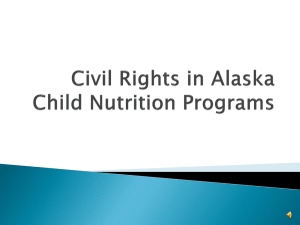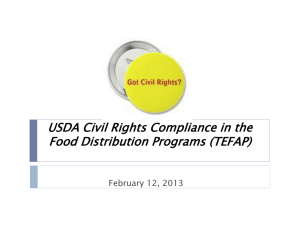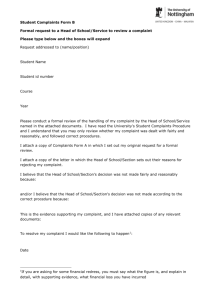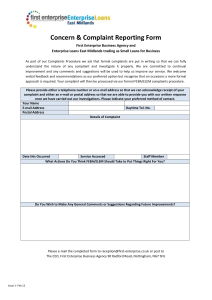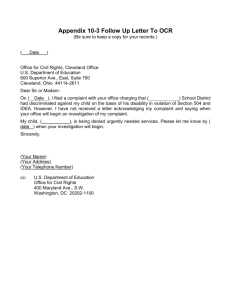FNS Instruction 113-1 - Alabama Department of Education
advertisement
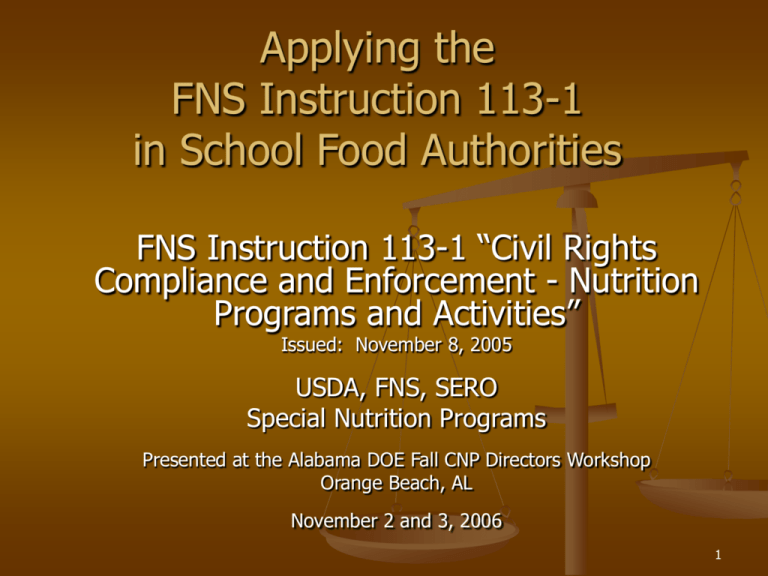
Applying the FNS Instruction 113-1 in School Food Authorities FNS Instruction 113-1 “Civil Rights Compliance and Enforcement - Nutrition Programs and Activities” Issued: November 8, 2005 USDA, FNS, SERO Special Nutrition Programs Presented at the Alabama DOE Fall CNP Directors Workshop Orange Beach, AL November 2 and 3, 2006 1 Prior policy was conveyed through a series of 8 FNS Instructions: 113-1, Civil Rights Compliance and Enforcement (issued May 1982), as the overarching instruction; and sequentially numbered instructions were program-specific. 2 The recently issued FNS Instruction 113-1 Merges all of the previously independent instructions into 1 document; 4 appendices that provide program-specific guidance; and 2 appendices that provide sample documents and a chart demonstrating information and time requirements. 3 The Appendices are: Appendix Appendix Appendix Appendix A: B: C: D: Food Stamp Program Child Nutrition Programs Food Distribution Programs WIC and WIC Farmers’ Market Nutrition Program (FMNP) Appendix E: Sample Complaint Forms Appendix F: Complaint Processing and Procedures Flowchart 4 What does the recently issued 113 change? amends certain required procedures; affords equal opportunity for religious organizations; clearly establishes complaint handling procedures; and is a single reference for civil rights compliance and enforcement. 5 New Sections Limited English Proficiency (LEP) Equal Opportunity for Religious Organizations Appendices 6 I. PURPOSE Establishes and conveys policy Provides guidance and direction to USDA, FNS and its recipients and customers Ensures compliance with and enforcement of the prohibition against discrimination in all FNS programs and activities, whether federally funded in whole or not. 7 II. AUTHORITY Title VI of the Civil Rights of 1964 – race, color, and national origin American with Disabilities Act – disability Title IX of the Education Amendments of 1972 – sex Section 504 of the Rehabilitation Act of 1973 – disability Age Discrimination Act of 1975 – age 8 II. AUTHORITY The Personal Responsibility and Work Opportunity Reconciliation Act of 1996, and DOJ Memorandum dated 1/28/99, entitled, “Policy Guidance Document – Enforcement of Title VI of the Civil Rights Act of 1964 and Related Statutes in Block Grant Type Programs.” Civil Rights Restoration Act of 1987 – clarifies the scope of the Civil Rights Act of 1964. Food Stamp Act of 1977 – added religious creed and political beliefs as protected classes in the Food Stamp Program. 9 II. AUTHORITY Executive Order 13166 – enforces National Origin discrimination for persons with Limited English Proficiency. USDA Departmental Regulation 4330-2 – prohibits discrimination in programs and activities funded by USDA. 7 CFR Part 16, Equal Opportunity for Religious Organizations – religiously affiliated organizations should be able to compete on an equal footing with other organizations for USDA assistance. 10 III. POLICY Protected Classes for FNS Programs Race Color National Origin Age Sex Disability Religion (FSP & FDPIR only) Political Beliefs (FSP & FDPIR only) 11 III. POLICY The U.S. Department of Agriculture prohibits discrimination in all its programs and activities on the basis of race, color, national origin, age, disability, and where applicable, sex, marital status, familial status, parental status, religion, sexual orientation, genetic information, political beliefs, reprisal or because all or part of an individual’s income is derived from any public assistance program. (Not all prohibited bases apply to all programs.) Persons with disabilities who require alternative means for communication of program information (Braille, large print, audiotape, etc.) should contact USDA’s TARGET Center at (202) 720-2600 (voice and TTY). 12 IV. APPLICABILITY This Instruction is applicable to all programs and activities of a recipient of Federal financial assistance, whether those programs and activities are federally funded in whole or not. 13 VII. LIMITED ENGLISH PROFICIENCY (LEP) Definition: Individuals who do not speak English as their primary language and who have a limited ability to read, speak, write, or understand English. Recipients of Federal financial assistance have a responsibility to take reasonable steps to ensure meaningful access to their programs and activities by persons with limited English proficiency. 14 VII. LEP Factors to consider in addressing LEP: Number or proportion of LEP persons served or encountered in the eligible population. Frequency with which LEP individuals come in contact with the program. Nature and importance of the program activity, or services provided. Resources available to the recipient and costs. 15 VII. LEP NSLP Household applications in foreign languages can be found at: www.fns.usda.gov/cnd/FRP/frp.process.htm For further information on LEP: www.LEP.gov 16 VIII. EQUAL OPPORTUNITY FOR RELIGIOUS ORGANIZATIONS Ensures a level playing field for the participation of faith-based organizations and other community organizations in USDA programs. 17 VIII. EQUAL OPPORTUNITY FOR RELIGIOUS ORGANIZATIONS This is accomplished by: prohibiting discrimination on the basis of religion, religious belief, or religious character in the administration of Federal funds; allowing a religious organization that participates in USDA programs to retain its independence and continue to carryout its mission, provided that direct USDA funds do not support any inherently religious activities such as worship, religious instruction, or proselytization; 18 VIII. EQUAL OPPORTUNITY FOR RELIGIOUS ORGANIZATIONS clarifying that faith-based organizations can use space in their facilities to provide USDA-funded service without removing religious art, icons, scriptures, or other religious symbols; and ensuring that no organization that receives direct financial assistance from the USDA can discriminate against a program beneficiary, on the basis of religion or religious belief. 19 VIII. EQUAL OPPORTUNITY FOR RELIGIOUS ORGANIZATIONS For further information: www.fbci.gov 20 IX. PUBLIC NOTIFICATION All FNS assistance programs must include a public notification system. The purpose of this system is to inform applicants, participants, and potentially eligible persons of: program availability, program rights and responsibilities, the policy of nondiscrimination and the procedure for filing a complaint. 21 3 Elements of Public Notification 1. Program Availability 2. Complaint Information 3. Nondiscrimination Statement 22 3 Elements of Public Notification 1. Program Availability Inform applicants, participants, and potentially eligible persons of their program rights and responsibilities and the steps necessary for participation. 23 3 Elements of Public Notification 2. Complaint Information Advise applicants and participants at the service delivery point of their right to file a complaint, how to file a complaint, and the complaint procedures. (example: “And Justice for All” poster) 24 3 Elements of Public Notification 3. Nondiscrimination Statement All information materials and sources, including Web sites, used by FNS, State agencies, local agencies, or other subrecipients to inform the public about FNS programs must contain a nondiscrimination statement. The statement is not required to be included on every page of the program Web site. At a minimum the nondiscrimination statement or a link to it must be included on the home page of the school food service program information. 25 3 Elements of Public Notification Nondiscrimination Statement : All other FNS Programs, State or local agencies, and their subrecipients, must use the following statement: “In accordance with Federal law and U.S. Department of Agriculture policy, this institution is prohibited from discriminating on the basis of race, color, national origin, sex, age or disability. To file a complaint of discrimination, write USDA, Director, Office of Civil Rights, 1400 Independence Avenue, SW, Washington, D.C. 20250-9410 or call (800) 795-3272 or (202) 720-6382 (TTY). USDA is an equal opportunity provider and employer.” 26 3 Elements of Public Notification If the material is too small to permit the full Nondiscrimination Statement in the material, at a minimum the following must be included: “This institution is an equal opportunity provider.” 27 3 Elements of Public Notification Nondiscrimination Statement for FSP and FDPIR State or local agencies and their subrecipients must use the following statement*: “In accordance with Federal law and U.S. Department of Agriculture policy, this institution is prohibited from discriminating on the basis of race, color, national origin, sex, age, religion, political beliefs, or disability. To file a complaint of discrimination, write USDA, Director, Office of Civil Rights, 1400 Independence Avenue, S.W., Washington, D.C. 20250-9410 or call (800) 795-3272 (voice) or (202) 720-6382 (TTY). USDA is an equal opportunity provider and employer.” * Exception provided for the use of a joint application for FSP/HHS— see Instruction for approved language 28 Methods of Public Notification Prominently display the “And Justice for All” poster. Inform potentially eligible persons, applicants, participants and grassroots organizations of programs or changes in programs. Provide appropriate information in alternative formats for persons with disabilities. Include the required nondiscrimination statement on all appropriate FNS and agency publications, Web sites, posters and informational materials. Convey the message of equal opportunity in all photos and other graphics that are used to provide program or program-related information. 29 30 XI. CIVIL RIGHTS TRAINING State agencies are responsible for training local agencies on an annual basis. Local agencies are responsible for training their subrecipients, including “frontline staff” who interact with applicants or participants on an annual basis. 31 XI. CIVIL RIGHTS TRAINING Specific subject matter required, but not limited to: Collection and use of data; Effective public notification systems, Complaint procedures, Compliance review techniques, Resolution of noncompliance, Requirements for reasonable accommodation of persons with disabilities, Requirements for language assistance, Conflict resolution, and Customer service. 32 XII. DATA COLLECTION AND REPORTING The purpose is to: determine how effectively FNS programs are reaching potential eligible persons and beneficiaries, identify areas where additional outreach is needed, assist in the selection of locations for compliance reviews, and complete reports, as required. 33 What are the Collecting and Reporting Expectations for SFAs? At this time SFAs are not required to collect or report data. Data collection is done by the local education agency (LEA) at the time students enroll and the LEA reports this information to the State DOE through appropriate reporting mechanisms. 34 Race and Ethnic Categories Two Question Format 1. Ethnicity: Hispanic or Latino Not Hispanic or Latino 35 Race and Ethnic Categories Two Question Format 2. Race American Indian or Alaskan Native Asian Black or African American Native Hawaiian or Other Pacific Islander White 36 XIII. COMPLIANCE REVIEWS A compliance review examines activities to determine adherence with civil rights requirements for: State agencies, local agencies, and other subrecipients. 37 Compliance Reviews 3 Types of Compliance Reviews: Pre-approval or Pre-award (State & Federal) Post-award or Routine (State & Federal) Special (Federal) 38 Compliance Reviews Pre-approval or Pre-award Compliance Reviews No federal funds shall be made available to a State agency or local agency until a Pre-award Compliance Review has been conducted and the applicant is determined to be in compliance with civil rights requirements. 39 Compliance Reviews Post-Award or Routine Compliance Review Selection based on an indication of possible concerns such as: scheduled CRE; an unusual fluctuation in participation of racial or ethnic groups in a service area; the number of discrimination complaints filed; information from grassroots and advocacy groups; individuals and State officials; and unresolved findings from previous civil rights reviews. 40 Compliance Reviews Post-Award or Routine Compliance Review Content Complaint process; Training; Non-discrimination statement usage; Analysis of denied applications. 41 Compliance Reviews Post-Award or Routine Compliance Review Content When a review of a local agency or other subrecipient is performed, by either the FNS Region, the State agency or your office, the following items should be determined: Whether potentially eligible persons and households have an equal opportunity to participate in the program; Whether case records are coded by race or ethnic origin; Whether offices and cafeterias are displaying the “And Justice for All” poster in a prominent location; Whether the nondiscrimination statement is included on all printed materials distributed to the public and on web sites; and whether graphic materials reflect inclusiveness based on race, color, national origin, age, sex, and disability; Rev. 10/06 42 Compliance Reviews Post-Award or Routine Compliance Review Content Whether program information is made available to potentially eligible persons, program applicants and participants; Whether the local agency is providing program information to organizations within the community; Whether civil rights complaint processing is handled in accordance with the FNS Instruction 113-1 or other applicable authorities; and Whether the local agency has conducted civil rights training for its staff. Rev. 10/06 43 Compliance Reviews State agencies review local agencies. Local agencies review their sub-recipients. CRE Annual site reviews completed by February 1, each year. State and local agencies must report significant findings to the reviewed entity and FNS. 44 Compliance Reviews Special Compliance Reviews Conducted by FNS when: Program participation data indicates that a particular group in a specific area is not benefiting from an FNS program; reports of alleged noncompliance made by the media, grassroots organizations, or advocacy groups need to be resolved; 45 Compliance Reviews Special Compliance Review reports of alleged noncompliance made by other agencies, such as US Dept. of Ed. and HHS, need to be resolved; or patterns of complaints of discrimination have been documented; or a complaint is received by a participant through the complaint procedures. 46 XIV. RESOLUTION OF NONCOMPLIANCE Definition of “Noncompliance” A factual finding that any civil rights requirement, as provided by law, regulation, policy, instruction, or guidelines, is not being adhered to by a State agency, local agency, or other subrecipient. 47 A finding of noncompliance may be the result of: a CRE or a Civil Rights Compliance Review; a special review; or an investigation. 48 What are some examples of noncompliance? Denying an individual or household the opportunity to apply for program benefits or services on the basis of a protected class. Providing FNS program services or benefits in a disparate matter on the basis of a protected class (except as a disability accommodation). 49 What are some examples of noncompliance? Selecting members for planning and advisory bodies in such a way as to exclude persons from membership on the basis of a protected class. Selecting FNS program sites or facilities in a manner that denies an individual access to FNS program benefits, assistance, or services on the basis of a protected class. 50 What happens once noncompliance is determined? Steps must be taken immediately to obtain voluntary compliance. Effective date of the finding of noncompliance is the date of notice to the State agency, local agency, or other subrecipient. 51 To achieve voluntary compliance, FNS will: Provide immediate written notice to the local agency or other subrecipient indicating: the areas of noncompliance, and the action required to correct the situation. Negotiate with the local agency or other subrecipient to achieve compliance. If corrective action has not been completed within 60 days of the finding, submit Report of Findings of Noncompliance in letter format to the FNS Regional Administrator with attachments. 52 XV. COMPLAINTS OF DISCRIMINATION Recognizing a CN Civil Rights Complaint-allegation based on: Race, Color, National Origin, Age, Sex, or Disability. 53 XV. COMPLAINTS OF DISCRIMINATION timeframes for processing must be adhered to (complaints must be submitted to FNS within 3 business days); Right to File: complaint must be filed in 180 days; complaints may be written or verbal as well as anonymous; the use of a form is not required though provided as a prototype in the Instruction; 54 XV. COMPLAINTS OF DISCRIMINATION certain key information should be requested; a letter of acknowledgement is sent to the complainant; age discrimination complaints are referred to Federal Mediation Conciliation Service within 10 days; the parties are encouraged to resolve the issue at the lowest possible level, as expeditiously as possible; and if finding(s), corrective action required. 55 XVI. GUIDELINES FOR PROCESSING CIVIL RIGHTS COMPLAINTS Appendix F: Review of FNS 113 Complaint Processing Procedures and Timelines; Complaints may be received by USDA, FNS-HQ, FNS-SERO, other Executive Recipients, SAs or SFAs; All complaints must be resolved within 90 days of receipt; and the State Operations Plan must contain a description of the agency’s discrimination complaint/grievance processing system. 56 Is this a Civil Rights Complaint? An autistic middle school student forgets her lunch money for the fourth time. The paraprofessional tells the cashier to give the child two packages of saltine crackers and tells the child that “This will teach you not have your lunch money again”. The child’s mother writes a letter to the Secretary of Agriculture alleging discrimination based on the childs autism. Is this a civil rights complaint and should it be reported? Yes. It should be considered a complaint even if it appears to be a program related issue. The results of the investigation determined that it was a program complaint. Improper application of the SFA charge policy and a potential violation of the FNS Instruction 791.1 Prohibition Against Denying Meals and Milk to Children as a Disciplinary Act 57 Is this a Civil Rights Complaint? A parent contacts the School Food Service Director and says their child is being denied their religious right to be able to eat only vegetarian meals. Is this a civil rights complaint and should it be reported? No. Religion is not a protected class in Child Nutrition Programs under FNS Instruction 113-1 Civil Rights Compliance and Enforcement – Nutrition Programs and Activities . It would be suggested that the SFA try to work with the complainant and try to accommodate there religious needs. 58 Is this a Civil Rights Complaint? A minority high school football player approaches the cafeteria manager and says he isn’t getting enough food when he selects a reimbursable meal and would like larger servings. Is this a civil rights complaint and should it be reported? No. Just because the student is a minority student does not mean he automatically is considered to be alleging discrimination. He did not state that he was not getting adequate servings because of his minority status. He only wants a larger serving. If he had said that he was not getting a large enough serving because of his racial/ethnic background, then, Yes, it would be a complaint and you would need to report it. 59 Questions? 60
